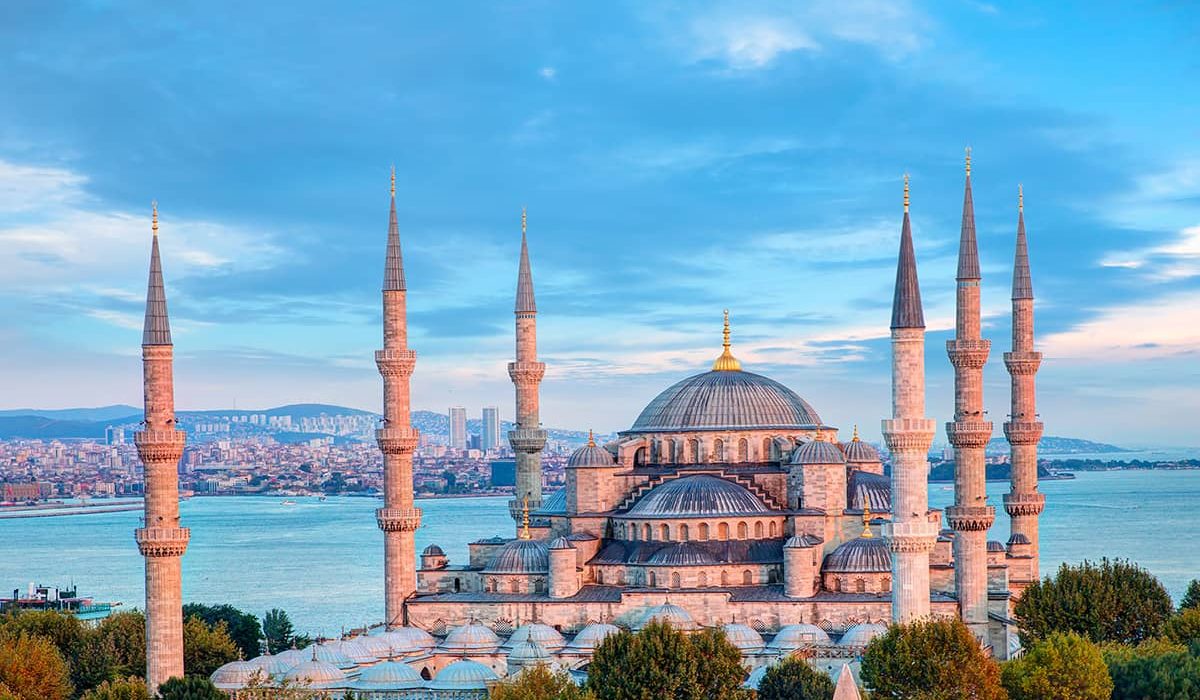The Blue Mosque In Istanbul, officially known as the Sultan Ahmed Mosque, is one of Istanbul’s most iconic landmarks. Renowned for its striking blue tiles and majestic architecture, this historical mosque draws millions of visitors annually. This comprehensive guide will delve into the rich history and architectural marvels of the Blue Mosque, providing essential information for those planning a visit.
Historical Significance of the Blue Mosque
The Blue Mosque In Istanbul was commissioned by Sultan Ahmed I, who ascended to the Ottoman throne in 1603. The mosque’s design was intended to rival the nearby Hagia Sophia, a former Byzantine cathedral, symbolizing the Ottoman Empire’s religious and architectural dominance.
Sultan Ahmed I’s decision to build the mosque on the historical site of the old Byzantine imperial palace and hippodrome underscored the mosque’s importance. The Masjid Blue Mosque was a place of worship and an expression of the empire’s power and prestige. It represents the zenith of Ottoman architecture and is a significant symbol of Istanbul.
Architectural Wonders of the Blue Mosque
Exterior Design
The Blue Mosque’s exterior is a marvel of Islamic architecture. The mosque features a large central dome flanked by four minarets, which were added to accommodate the increasing number of worshippers. The mosque’s use of blue Iznik tiles on its interior walls gives it its distinctive name and a serene, calming atmosphere.
Interior Design
The interior of the Blue Mosque is equally breathtaking. The mosque’s main prayer hall is vast and open, with a central dome rising 43 meters above the floor. The space is illuminated by over 200 stained glass windows, which bathe the interior in a colorful, ethereal light.
The mosque’s carpet, a modern addition, features a deep red color and traditional designs, complementing the blue tiles and enhancing the space’s overall beauty. The Blue Mosque’s interior design integrates functionality and aesthetics, creating a harmonious environment for worship and reflection.
Courtyard and Minarets
The mosque’s courtyard is one of the largest in the Islamic world, providing ample space for congregational prayers and gatherings. The four minarets, each with three balconies, stand tall and majestic, providing a visual balance to the mosque’s central dome and adding to its impressive silhouette.
Visiting the Blue Mosque: Essential Information
The Blue Mosque Location
The Blue Mosque is located in Sultanahmet, a historic district in Istanbul. Its central location makes it easily accessible from other significant landmarks such as the Hagia Sophia and the Topkapi Palace. The mosque’s address is:
Sultanahmet, 34122 Fatih/Istanbul, Turkey
Blue Mosque Entrance Fee
One of the most appealing aspects of visiting the Blue Mosque is no entrance fee. The mosque is open to visitors outside of prayer times, allowing tourists to explore its architectural wonders and historical significance without any cost.
Blue Mosque Opening Hours
The Blue Mosque is open to visitors every day of the week. However, visitors should be mindful of the mosque’s prayer schedule, as it may affect the visiting hours:
- Daily Visiting Hours: 9:00 AM to 5:00 PM
- Prayer Times: During the five daily prayers, the mosque is closed to non-worshippers. These times vary, so checking the current prayer times before planning your visit is advisable.
Blue Mosque Tickets
Visitors can walk in during the designated visiting hours, but it is recommended to dress modestly and respectfully. The mosque provides shawls and headscarves for those who may need them.
Tips for Visiting the Blue Mosque
Dress Code
As a functioning mosque, the Blue Mosque has a strict dress code to ensure respect and modesty. Visitors should wear clothing that covers their shoulders and knees. Appropriate dress is crucial for entry into the mosque.
Avoiding Crowds
To avoid large crowds, visiting early in the morning or later in the afternoon is best. Weekdays are less crowded than weekends, offering a more serene experience.
Respectful Behavior
While visiting the Blue Mosque, it is essential to maintain a respectful demeanor. Keep noise to a minimum, avoid disruptive behavior, and follow the guidelines set by the mosque staff.
Nearby Attractions
While in Sultanahmet, take the opportunity to explore other nearby attractions:
- Hagia Sophia: A former Byzantine cathedral turned mosque and now a museum, offering a fascinating blend of Christian and Islamic architecture.
- Topkapi Palace: The opulent palace of Ottoman sultans featuring exquisite gardens, courtyards, and historical artifacts.
- Basilica Cistern: An ancient underground water reservoir with impressive columns and a unique ambiance.
Conclusion
The Blue Mosque in Istanbul is more than just a place of worship; it is a testament to the architectural brilliance and cultural richness of the Ottoman Empire. Its historical significance and architectural splendor make it a must-visit destination for anyone traveling to Istanbul.
Plan your visit to the Blue Mosque with this comprehensive guide, and immerse yourself in the beauty and heritage of one of Istanbul’s most iconic landmarks. For more travel tips and insights, follow Travel Nags – your ultimate travel resource!
Read More: The Blue Mosque in Istanbul: Historical Significance and Architectural Wonders

